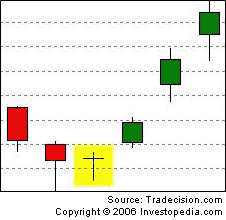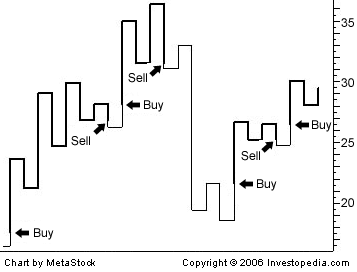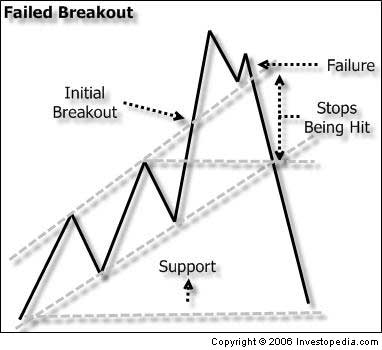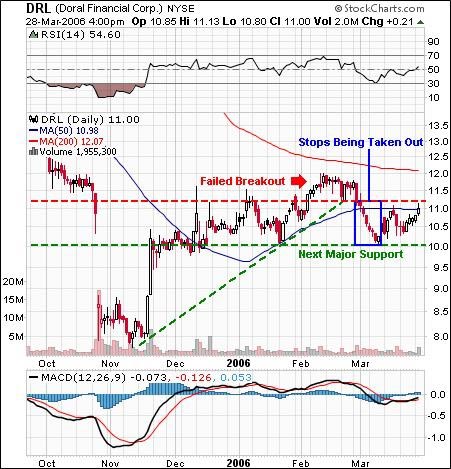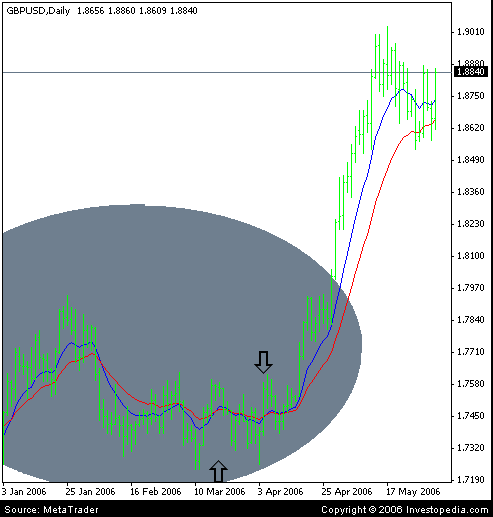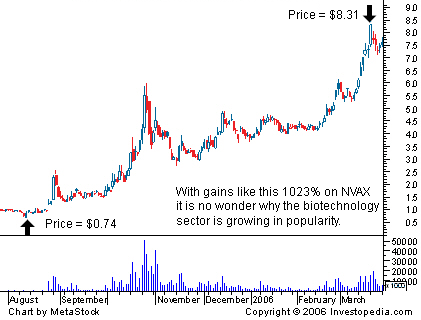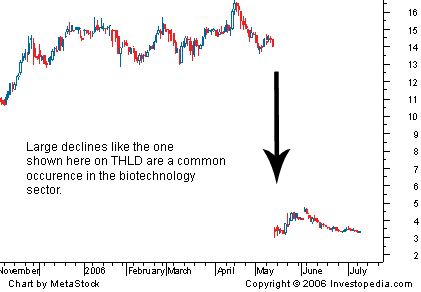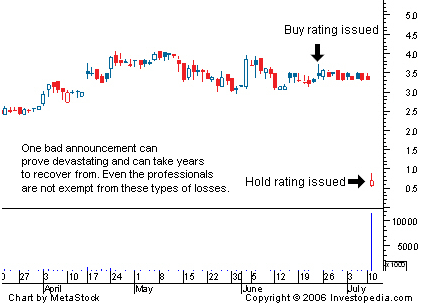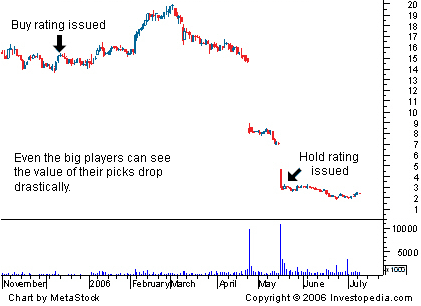Anyone who has relied on "hot" news or company fundamentals to buy a stock knows that this practice often leads to disappointing results. The reason is simple. Fundamental analysis data lags the market. Earnings news can be as much as over a month old when released. In the majority of cases, by the time news announcements are made, the stock has usually already made its move.
Also, what if the fundamentals change? Most fundamental investors maintain the belief that it is better to hold onto a stock through thick and thin and hope the company recovers once better times return. But as we saw through the 2000 – 2002 bear market correction and all bear markets before it, this approach can lead to complete disaster.
The continued popularity of the traditional buy-and-hold strategy is due in no small part to the 18-year bull that ended in 2000. During this market, the buy-and-hold approach to investing worked great, but then so did throwing darts. It was only when the market turned to a bear that the fundamental flaw in this method became obvious.
| |
At the opposite end of the spectrum, technical analysis ignores fundamentals altogether and focuses strictly on technical indicators and chart patterns. While an excellent method of short-term trading, it can lead to losses in longer-term trades unless the trader continually readjusts profit targets and stop-losses. Also, this type of on-going maintenance may not be everyone's cup of tea and can cause unnecessary stress.
In reality, unless you are a pure technical trader employing very short time horizons to day trade or swing trade, using one method of analysis while ignoring the other is like trying to win a boxing match with one hand tied behind your back.
So what is the best combination of technical and fundamental methods for the busy trader or investor, and how does one become a truly proficient "technimental" trader (which you can read more about in "Charting Your Way to Better Returns")?
Time Frame Target
In the article entitled "Trader's Corner – Shoot for the Moon…And Hit It!," I highlight the techniques of stock-trading record-holder Dan Zanger. Dan is a pedal-to-the-metal kind of swing trader who likes to buy highly volatile stocks on margin that are in the process of either breaking out or breaking down. He gets in quick and may stay in anywhere from a few hours to a number of days or in some cases, even weeks.
"If you're a day trader who takes positions for a few minutes to a few hours, fundamentals are pretty much meaningless," he says. "Their importance in the decision making process is directly proportional to the anticipated time to be spent in a position."
However, using the premise 'cut losses short and let your profits ride' means that unless the trade goes against you at the beginning, it's hard to know exactly how long to hold the position. As long as it's moving up on volume, Zanger holds on.
The moral is that even on anticipated shorter-term trades of a day or so, it's important to have at least a rudimentary understanding of the fundamental strengths (and weaknesses) of a company because, if you are lucky, it will turn into a longer-term proposition.
What's a CANSLIM?
Zanger takes what he calls a top-down approach when looking for stocks to buy. First he looks for stocks putting in "interesting chart patterns on increasing volume." If the stock is acting frisky, there is generally a fundamental reason why; often institutions are accumulating the stock and the chart pattern is simply proof of this.
Zanger is a firm believer in the CANSLIM strategy, as this magic formula contains almost everything he needs to know about a company before buying it. There is a summary of the CANSLIM formula in William O'Neil's essential market bible called How to Make Money in Stocks: A Winning System in Good Times and Bad. (You can also read about CANSLIM in "Guide to Stock Picking Strategies.") O'Neil recommends that you buy only companies exhibiting certain fundamental and technical characteristics. Zanger has added some of his own criteria, and, interestingly, he has discovered over the years that stocks demonstrating interesting chart patterns on volume very often turn out to fulfill most if not all of the CANSLIM criteria. Here is a summary of the CANSLIM criteria, including the way Zanger uses them.
C = Current Quarterly Earnings/Share Growth - For Zanger, this must be up a minimum of 40% and quarterly sales accelerating at 40% or better. (In the book, O'Neil recommends, "earnings must be up 18 – 20%, the higher the better." Zanger requires double this as a minimum.) O'Neil also recommends that quarterly sales be accelerating or up 25%. As well, Zanger looks for companies with both earnings and revenues that demonstrate a continual quarter-over-quarter sequential expansion, known as "ramping up." In retailers, however, he looks for year-over-year expansion (due to the seasonal volatility of the industry). A = Annual Earnings Growth - Studies by O'Neil's Investor's Business Daily show that winning stocks over the last 50 years had a return on equity (ROE) of 17% or more. Any CANSLIM-worthy stock should demonstrate this kind of ROE in each of the last three years. The higher the annual growth, the better the candidate. N = New Products, New Management, and New Highs – The company should offer new products/services, with new management and/or industry innovations. A pivotal technical consideration of this point is to buy only stocks that are emerging from basing chart patterns and that have put in a new stock-price high out of the base or consolidation. Zanger looks for companies that have a global domination in their market space and that are also "under-known and under-owned." This means institutions that don't yet have these stocks in their portfolio are to become major buyers, at which point they create demand for the stock and in turn push up the stock price. S = Supply and demand in share volume/shares that float - The supply part (shares outstanding) is of less importance here than demand. The company should demonstrate increasing volume as price moves out of a basing chart pattern such as a cup and handle, saucer bottom, or head and shoulders bottom. Other patterns such as flags or pennants and bullish wedges also represent excellent buying opportunities when the breakouts are accompanied by greater-than-average volumes. Other major factors are the total number of shares that the public can buy, and this is known as the float. A small number of shares that float means that fewer shares have to be bought to push up the stock price. Dan likes to see stocks with 3 million to 100 million shares that float. TASR, one of Dan's big winners in 2003-2004, started out with just 3 million shares that floated on its 5000% run in one year. L = Leader (or Laggard)? - Buy market, sector and industry leaders. Sell laggards. Own the industry leaders and sell them when they no longer lead. This also applies to the sectors and groups in which they reside. I = Institutional sponsorship - Look for stocks with a good degree of institutional (= professional) participation. This includes those with a higher degree of corporate executive ownership. M = Market direction - As much as 70% of a stock's price movement is determined by the direction of the overall market. Even a winner will be fighting a strong current to get to higher prices in a market that is tanking. It is best to be long winners in a bull market (and short losers in a bear market). |
Other fundamentals of importance include:
- Short interest – A large short interest gives a clue as to what other traders are doing. A general rule of thumb is to avoid stocks with more than 5% of the float held short.
- Insider selling – Insider activity can often provide valuable indications of where a stock may be heading. If insiders are buying for the first time in a number of months, they might be accumulating stock in anticipation of a positive event. If they are dumping, what do they know that you don't? More on this in my article "Can Insiders Help You Make Better Trades?"
Once a stock has been identified as a potential CANSLIM candidate, Zanger watches it for a few days to make sure it is not simply a one-day wonder. Some of his big winners in 2003 -2004 have included Research in Motion (RIMM), E-Bay (EBAY), Kmart (KMRT), Taser, INC. (TASR), NVE Corp (NVEC), PalmOne (PLMO), and Travelzoo (TZOO).
Zanger offers one important caveat: while it's true that most stocks that he trades are CANSLIM stocks, there are two important exceptions that show why checking the fundamentals is so important. Firstly, he says that Biotechs often act like CANSLIM stocks but don't have earnings growth and other positive criteria. And secondly, he says that near the end of a major bull run in the markets, after most of the quality stocks have already moved and are starting to exhaust themselves, the trash stocks will get pushed higher as investors scramble to find the "next big thing." A rising tide lifts all boats including those that don't have the fundamentals behind them. Loading up on these trash stocks late in the game can lead to serious losses and a situation that can be avoided by looking at the fundamentals.
Automating the Process
Although Zanger's charting program of choice is AIQ, there is a tool that, combining technicals and fundamentals into one package, will appeal to the technimental trader. Called High Growth Stocks, the program uses data from Quotes-Plus to provide charts on more than 8,000 stocks. It streamlines the process of looking at technicals and fundamentals together. Custom filters that include fundamental criteria can be used to scan for stock candidates meeting a number of fundamental and technical criteria.
Research in Motion, developer of the ubiquitous technology toy "Blackberry," is shown in figure 1. It has been a classic CANSLIM prospect. First, RIMM's Blackberry now has complete product domination in first world countries and is revolutionizing the personal digital appliance market. It can send and receive e-mail, make phone calls, and perform many of the functions of a computer in the palm of your hand. And, most importantly, it is the market leader in this field.
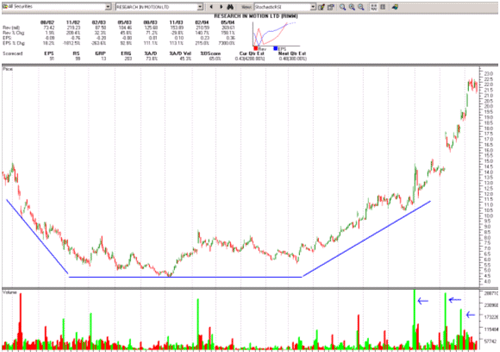 |
| Figure 1 – Research in Motion (RIMM) showing basing saucer pattern (blue lines) followed by breakouts on volume (lower blue arrows). Earnings in upper chart window show a 3600% increase in the current quarter. Chart provided by http://www.highgrowthstock.com. Data by http://www.quotes-plus.com/ |
Even after a split in early 2004, the stock has only a total of 117 million shares in the float and only 158 million outstanding. In 2001-03, it showed an interesting long-term saucer pattern after which it experienced a number of impressive volume spikes. It also demonstrated impressive revenue and earnings growth. As we see in the upper High Growth Stocks window in figure 1, quarterly earnings grew from 92% per quarter in mid-2003 to 7300% by mid-2004.
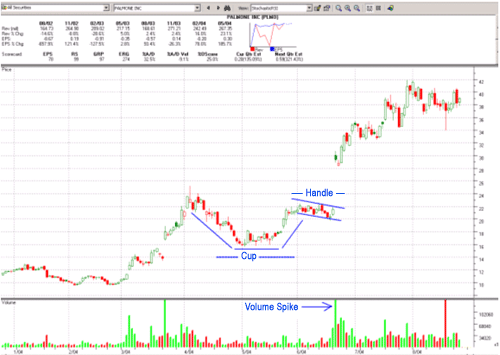 |
| Figure 2 – PalmOne Inc. (PLMO) showing cup and handle pattern followed by breakout on volume. Earnings info in upper window. Chart provided by http://www.highgrowthstock.com. Data by http://www.quotes-plus.com/ |
PalmOne Inc., candidate number 2, also demonstrated the necessary CANSLIM criteria including increasing earnings (upper window), a cup and handle chart pattern followed by a volume spike the pattern breakout.
More Words of Wisdom
Bill O'Neil's How to Make Money in Stocks Desk Diary 2004 is another essential tool for the serious trader or investor and offers sage wisdom on how to apply the CANSLIM formula 365 days of the year. It is a valuable source of information and goes a long way in dispelling a number of common misconceptions.
Here is what O'Neil has to say on P/E ratios:
"Never buy a stock solely because the P/E ratio makes it look like a bargain. There is usually a good reason why P/Es are so low, and there is no golden rule in the stock market that protects a stock that sells at 8 or 10 times earnings from going even lower."
"High P/Es that were great bargains--Xerox sold for 100 times earnings in 1960--before it advanced 3,300%. America Online sold for over 100 times earnings before it increased 14,900% in November 1994 to its top in December 1999."
"During the 1990-95 period, the real leaders began with average P/E of 36 that expanded into the 80s."
|
Here is what he has to say on volume:
"Major changes in volume can give you significant clues. A stock that trades up one point on 600% of its average volume alerts you to emerging professional interest in that stock."
And on chart patterns:
"Cup patterns can last from seven to as long as 65 weeks, but most are three to six months."
"Handles in a cup-with-handle pattern must form in the upper half of the overall base structure.... The handle should also be above the stock's 200-day moving average line."
Time – Your Most Precious Commodity
Dan Zanger has taken 20 years to hone his stock picking skills to a science, and his research often took days. But thanks to modern technology and the availability of some powerful programs and data sources, it no longer has to take that long to find all-around winning stock candidates. It is now possible to obtain that amount of information in minutes, for those who know how.
Zanger scans 1,400 stocks manually nightly to look for interesting candidates. He still must do a little manual digging to see if new prospects meet the requirement of offering a new product, management, or service, but that doesn't take long; the process is far faster than it used to be. He only needs to look at the chart and seven pieces of data for each. He is done his homework in anywhere from 30 to 60 minutes a day.
Conclusion
Those who do not use technical and fundamental data together often miss crucial pieces in the trading puzzle, leaving them at a distinct disadvantage against their more technically proficient and well-informed competitors. Purists who ignore either fundamental or technical information are making a mistake that could end up costing them plenty.
By adopting Zanger's top-down approach, locating stocks that are acting unusually frisky, and then examining their underlying fundamentals, traders or investors can find winning stocks in all types of market conditions in as little time as it takes to watch your favorite TV program. It is a lot more productive and rewarding to boot. No longer will you be at the mercy of bear or trading range markets.
So what are you waiting for?
By Matt Blackman
Matt Blackman, the host of TradeSystemGuru.com, is a technical trader, author, keynote speaker and regular contributor to a number of trading publications and investment/trading websites in North America and Europe. He also writes a weekly market letter.
